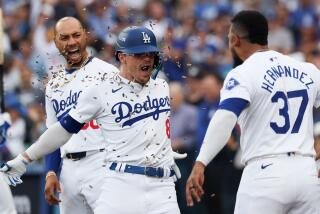Bud Harrelson Improves Mets’ Attitude
- Share via
What they remember was the pall in Davey Johnson’s office, swelling and spilling out into the clubhouse. And it choked them all.
The manager was working under a cloud that wasn’t of his own making, but it was real and poisonous.
And now there’s Bud Harrelson in a pair of bicycle shorts, his feet propped on the table in the middle of the post-game clubhouse kibitzing with the kibitzers.
“Look, there he’s sitting and talking to the guys,” Tim Teufel pointed out, as if it were a revelation. And maybe it is. It reveals the change in the attitude that had to be changed. “I didn’t know if it would happen,” Harrelson said. “It was one of my main projects -- to turn their approach to the game around.”
The contrast is as distinct as the Mets winning 12 of 15 after dropping three of their first four with Harrelson managing. Most significant is that they show life, an alertness that appeared out of the question.
They haven’t won anything yet. They’re not going to play .800 ball the rest of the way, but they have saved the season. They are four games behind when they could have come out of those two series with the Pirates 12 games behind and at the bottom of a deep well.
Harrelson held a meeting after an embarrassing loss in Philadelphia the first weekend of the month. “We still weren’t quite with it,” Harrelson said. “Then it was binga-bonga. All I know, it seemed to happen fairly fast.”
Before the binga-bonga, they were in jeopardy. “The tension was growing,” David Cone said. “Davey was managing with a gun to his head.”
The players are adults and professionals. They are supposed to be able to put aside things that don’t concern them directly and do the job for which they’re paid. After all, what difference should it make to the players that the front office had given them a manager on a banana peel?
“The uncertainty of waiting for him to be fired or a big trade to be made entered into everybody’s mind; it shouldn’t, but it did,” said Bob Ojeda, a skilled observer from the mound or the clubhouse. “The position they put Davey in reflected on the team.”
They, in this reference, was the front-office triumvirate headed by Frank Cashen. “Davey was maimed,” Ojeda said. “He didn’t look the same. His face, that air about him. It didn’t come across on TV or in the newspapers, but you could see it.”
Johnson wasn’t a great manager last season when he waited for big innings that didn’t come. For years, he’d been looking for another Cal Ripken to play shortstop at the expense of defense. Then this season the hitting stopped and the pitchers began worrying that if they had to pitch shutouts to win, who was going to catch the balls? They had good reason. Baseballs find holes like rainwater finds cracks in the basement.
“Baseball is not incredibly physical; it is incredibly mental,” Ojeda said. “This is the teamest game there is.”
They had terminal lethargy, and it wasn’t going to change as long as that cloud was there. They were crabbing and pointing at each other.
Now look at them, Harrelson said, “patting, shaking and slapping.”
Did the attitude get better and cause them to play better, or was it the other way around? Is the horse pulling the cart or is the cart actually pushing the horse? This is one of those rare times when there appears to be an answer.
“Attitude changed first, definitely,” said Darryl Strawberry, whose attitude made the greatest change. He looked so passive; he played so passively. His concentration always had been erratic in the outfield, but he’d always been an aggressive hitter and now he’d been through psychotherapy.
“He was a beaten man, no doubt about it,” Ojeda said. “He didn’t have that arrogance that made him ‘him.”’
Industrial psychology textbooks say that any change increases productivity for a while.
The Mets have been receptive to Harrelson, who has turned their heads around. He’s made it his business to reach as many players as possible every few days, and he’s managed to get more players into the game. That relieved some of the darkness on the bench.
And he’s made his changes. “Give him credit,” Ojeda said. “While he was being the bridesmaid, he was watching and observing.”
He has used Daryl Boston and Mark Carreon in center field. Rarely does a regular come off the waiver list, but Boston can play the position. Carreon isn’t a center fielder but he is an outfielder, which, as of last year, Keith Miller was not.
Harrelson let Mackey Sasser catch when the organization, clutching its six starting pitchers, chose to bring up a Double-A replacement.
He reached out to Strawberry, which he had to do, and however reluctantly put Dave Magadan at first base. Magadan looked like the world’s softest .300 hitter for three years, can’t run and was a minimal first baseman. Johnson was convinced of that. “I think Dave has changed,” Harrelson said.
They still are uncertain defensively. “But we’re better,” Ojeda said. They have been alert. They have been alive.
“This is the Bud Harrelson Era,” Teufel said. “He’s said whoever wants to follow, come on; whoever doesn’t, doesn’t have to be here; we’re going to get the blase attitude out of here. The change was needed.”
Who knows whether they can keep it up? “It’s working,” Strawberry said. That’s all the evidence there is.
More to Read
Go beyond the scoreboard
Get the latest on L.A.'s teams in the daily Sports Report newsletter.
You may occasionally receive promotional content from the Los Angeles Times.










